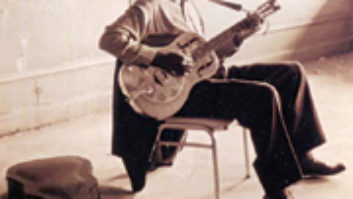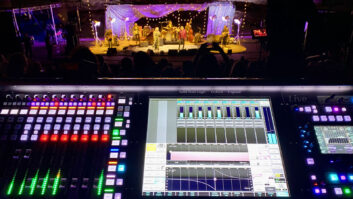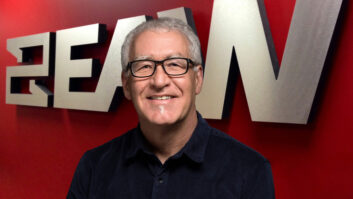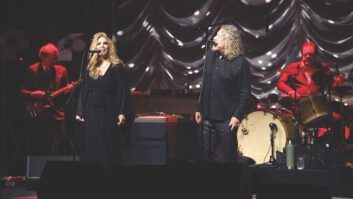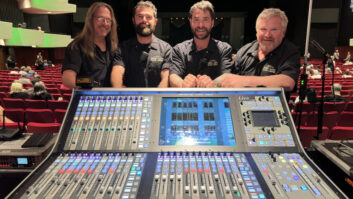Front-of-house engineer Gary Newell should be eligible for hazard pay as he travels across the globe with blues man Robert Cray. It’s not that Cray’s music is a mixing challenge for Newell — he’s been with Cray for 25 years now — or that the tour is taking them into dicey territories. Rather, from coast to coast, country to country, venue to venue, Newell walks into a gig never knowing what type of gear he’s going to get.
“We pick up front of house wherever we land,” he reports. “I have a different rig every day that I deal with, so I’ve had to learn how to use all the new digital consoles; I’ve had to keep up with all the new computer and processing stuff. It makes it interesting for me. The first thing I do when I get to a gig is turn the P.A. on, turn up the left side and then the right side and make sure they sound the same. About 40 percent of the time they don’t, which is really amazing. A lot of times, I spend half the day just trying to get one side to sound the same as the other.
“It’s not that uncommon to go ahead and EQ the left side and then EQ the right side and make sure they sound the same because the components aren’t sounding the same,” he continues. “Even in this day and age — with all this new technology — you’d think that wouldn’t be a problem anymore, but it still is.” To tune a P.A., Newell will turn to three songs — Sting’s “It’s Probably Me” from Ten Summoner’s Tales and “Love Wars” and “Baby I’m Scared of You” from Womack & Womack’s Love Wars album.
It’s a testament to his survival skills that Newell has succeeded while using all sorts of gear, from the new digital consoles to the 40-channel Crest HP-Eight desk that he worked on during the Robert Cray Band’s stop at San Francisco’s Herbst Theatre at the end of May. The show was one of the first on Cray’s summer tour that will take the band (drummer Kevin Hayes, keyboardist Jim Pugh and bassist Karl Sevareid) and crew across Europe before they drop onto the festival circuit.
During the San Francisco stop, Newell and crew worked with older Meyer cabinets. “I’d never seen that stuff before,” Newell says. “The house usually does acoustic gigs there and we were one of the biggest acts they’d seen, but we made it work. I had to mix in the balcony against the wall and I was the farthest person away from the P.A. in the theater. That made it kind of tough to make it sound good in the front and in the middle when you’re stuck up in the corner like that, but I’m used to it after 25 years and I can throw my ears down there and make it work. We got quite a few compliments and no complaints, so it worked.”
The crew ensured some consistency this time out by purchasing a monitor rig. According to monitor engineer Steve Selid, who has been with Cray for 14 years, the rig includes a Midas XL3 desk, a rack of QSC amps with BSS Minidrives, three Klark Teknik 370s, a pair of dbx 162SLs and a Lexicon PCM80. They’re carrying eight Sound Image 1212 wedges. “We also bought a Whirlwind snake,” Selid reports, “so when we go into venues, I can hand an XLR tail to them and say, ‘Plug in our inputs.’”
Although Selid asks about once a year, Cray still prefers wedges to any type of personal monitoring system. “Robert is old school and he likes to hear his vocal hitting him in the face and his guitar amps hitting him from behind,” he says. “It just makes him feel more like they are playing together. They play close together and set up tight so he can hear the band itself fine along with the P.A. [The monitors are] pretty low-level: It’s more about fidelity than volume.”
That mind-set helps with stage volume. “I try to keep the stage volume down so [Newell] can get a good mix going out front, but they do have pretty good control of their stage volume.” And that becomes more important as they move from venue to venue and Selid must compensate for the band’s needs. “Sometimes we have to change the levels a little bit,” he explains. “Sometimes I have to turn the mixes down about 5 dB because it’s a real small live room so Gary can get a good mix out front. At other places, it’s flat at zero and we rock it up.”
When asked how he mikes the drum kit, Newell says jokingly, “I start out with the kick drum and point one toward the hole. It’s like anybody else — I try to stick the mics toward the instruments that they are intended to pick up.” Pressed, though, he explains that Shure KSM32s are used as overheads, a Beyer M88 handles kick drum, Shure SM81s on the cymbals, Sennheiser 604s on the rack and floor tom, and the top and bottom of the snare is miked with Shure SM57s. “It’s a pretty simple kit and sometimes I throw a reverb on the snare, depending on the room,” he says.
Sevareid’s bass tones run through a Line 6 Bass Pod into a Mesa Boogie Basis M 2000 head, a Stewart World 1.2 power amp a Demeter tube bass preamp and a Bradshaw switcher. His cabinets are Hartke 15-inch and 4×10s and Newell mikes one of the 10-inch speakers with a Sennheiser 421. “We also run a signal before his amp rack into a Groove Tubes Ditto tube direct box that sends a nice fat tube signal down the line to me,” Newell explains. “So I have a DI signal and a separate mic signal and I blend those. Karl plays a pair of Fender Precision basses, a Jerry Jones bass with lipstick tube pickups and a Clevinger fretless stand up.”
Pugh plays a modified Hammond B3 with a Leslie cabinet that Newell mikes right and left at 45 degrees on top with Studio Project P1 mics; the bottom is miked with a Sennheiser 421. His piano setup is a Roland A90, and his rack includes a Rane SM 82 stereo mixer, an Aphex 109 parametric EQ with tube essence, a Roland P 330 digital piano module and a JV 880 module, and a Lexicon PCM70. Pugh also runs a Digidesign MBox with Reason on a Mac PowerBook G4.
Cray has a pair of Matchless Clubman 35 amps and a Fender Vibro-King. Both are miked with KSM32s. His rack includes a Tone Works tuner, a Samson UR5D wireless, a TC Electronic 2290 digital delay, a Peavey Valverb and a Zack Electronics Stereo Vibrato that was custom-made by Cray’s former guitar tech. He switches between Robert Cray model Stratocasters, a custom-made James Trussart steel Deville guitar and another custom guitar with a Telecaster body and neck and a block under the strings between the back pickup and the bridge so it sounds like a sitar. Cray uses that guitar on “Up in the Sky.” He sings into a Beyer M88.
One thing that 25 years with the same artist has given Newell is confidence to get his job done even as Cray picks songs from his entire catalog. “Robert does set lists that he puts on the stage for the band, but the crew isn’t allowed to have one,” he says with a laugh. “He wants to keep us guessing. The set list is only a guideline. He wants to keep it spontaneous.
“I’ve never even wanted a set list because I never needed one,” he continues. “It’s pretty simple because it’s a four-piece. I just push the faders up and if I get the P.A. sounding good, I hardly have to EQ the channels at all.”
David John Farinella is a San Francisco — based freelance writer.
